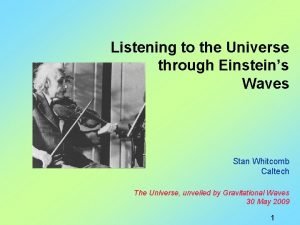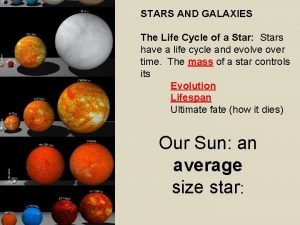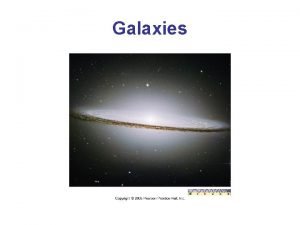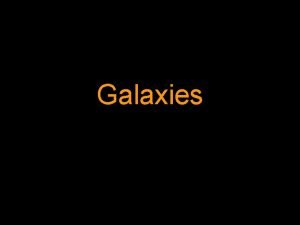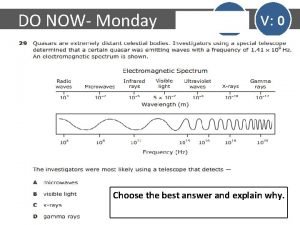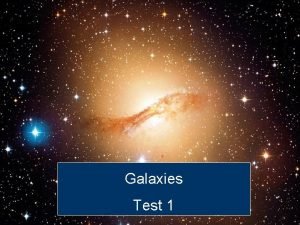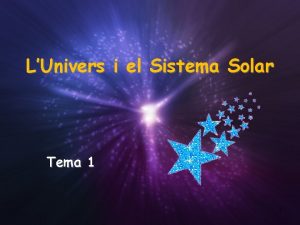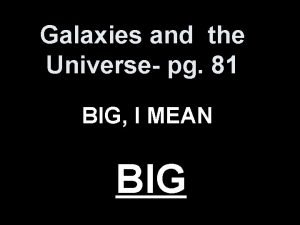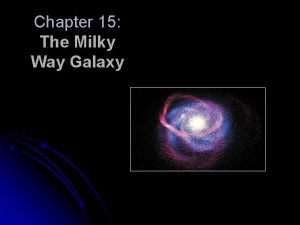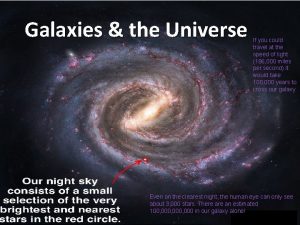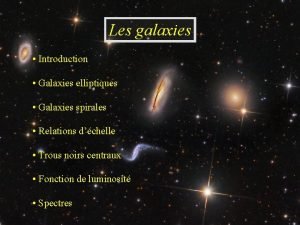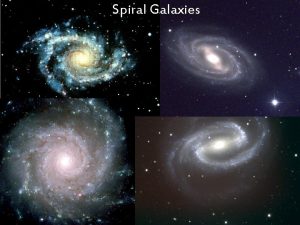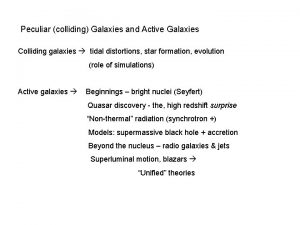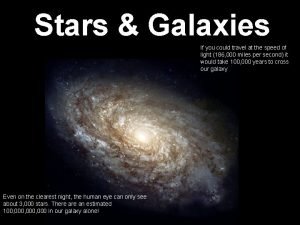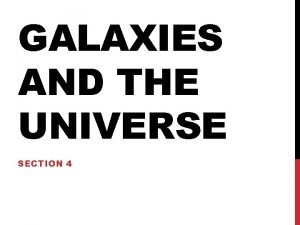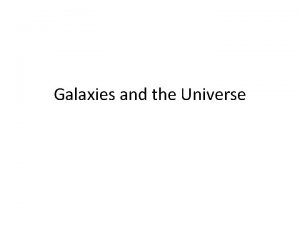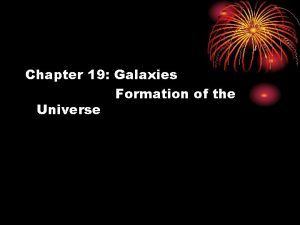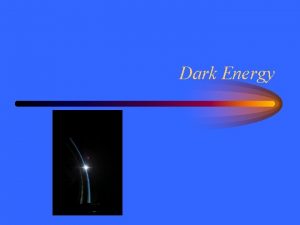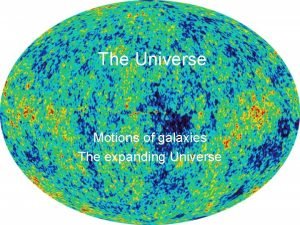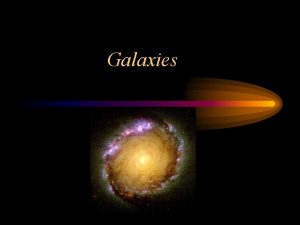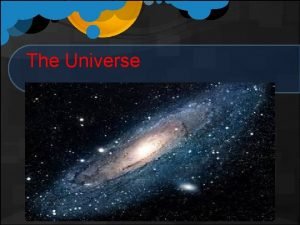Galaxies the Universe If you could travel at





















































- Slides: 53

Galaxies & the Universe If you could travel at the speed of light (186, 000 miles per second) it would take 100, 000 years to cross our galaxy Even on the clearest night, the human eye can only see about 3, 000 stars. There an estimated 100, 000, 000 in our galaxy alone!

• Alpha Centauri is 41, 000, 000 km away (25, 476, 218, 881, 730. 69 miles) • This is a BIG number to write. • Scientific Notation is used to make big numbers manageable. • 41, 000, 000 km becomes 4. 1 x 1013 km • Earth is 150, 000 km from the sun, what is it in Sci notation?

Radiation from Space Electromagnetic Radiation – Stars give off different wavelengths of light that make up the spectrum. – Light travels as a transverse wave.

– Transverse waves have crests and troughs. – The distance from one crest to another is called the wavelength. – The frequency is the number of wave crests that pass a certain point over time. – Amplitude is how high the wave gets above the equilibrium (balance i. e. the middle) Amplitude crest wavelength trough

– Radio waves (longest) – – – Microwaves Infrared Visible (R. O. Y. G. B. I. V. ) Ultraviolet X-Rays Gamma Rays (shortest)

• Radio: Radio waves are emitted by stars and gases in space. Not just for music! • Microwave: It will cook your popcorn in just a few minutes, but is also used by astronomers to learn about the structure of nearby galaxies. • Infrared: Night vision goggles pick up the infrared light emitted by our skin and objects with heat. In space, infrared light helps map the dust btw stars. • Visible: Our eyes detect visible light. Fireflies, light bulbs, and stars all emit visible light. • Ultraviolet: Ultraviolet radiation is emitted by the Sun and are the reason skin tans and burns. "Hot" objects in space emit UV radiation as well. • X-ray: A dentist uses X-rays to image your teeth, and airport security uses them to see through your bag. Hot gases in the universe also emit X-rays. • Gamma ray: Doctors use gamma-ray imaging to see inside your body. The biggest gamma-ray generator of all is the universe.

– Speed of light ≈ 300, 000 km/s – All forms of light travel at the same speed. According to Einstein's theory of special relativity objects gain mass as they speed up, and that speeding up requires energy. The more mass, the more energy is required. By the time an object reached the speed of light, Einstein calculated, its mass would be infinite, and so would the amount of energy required to increase its speed. To go beyond the infinite is impossible.

Light-years- the distance light travels in one year (9. 5 9. 46 x 1012 km trillion km in one year. ) » Proxima Centauri is the closest star to the Sun at 4. 3 ly. Parsec: the distance at which one astronomical unit subtends an angle of one arcsecond. It is equal to about 3. 26 light-years (31 trillion kilometers or 19 trillion miles) in length. Video

Measurement in Space • Parallax- the apparent shift in the position of an object when viewed from two different positions. » The closer the object is to the observer, the greater the parallax.

• Studying the Universe The cosmos contains approximately 50, 000, 000 galaxies. • Galaxy: Large group of stars, gas, and dust held together by gravity. • When you look up at the stars you are looking back in time! When you look at the Andromeda galaxy (which is 2. 3 million light years away), the light you are seeing took 2. 3 million years to reach you. Thus you are seeing the galaxy as it was 2. 3 million years ago.

Optical Telescopes – Telescopes that use light to produce magnified images of objects. Refracting Telescopes • Refraction is the bending of light as it passes through different materials. • A convex lens is used to bend the light and is magnified. • Galileo built the 1 st refractor.


Refraction & Refracting Telescopes

Reflecting Telescopes • Telescopes that use concave mirrors to reflect the light from an object to a focal point.


Hubble Space Telescope • Launched in 1990 • Placed in high Earth orbit, free of atmospheric distortion.

• Hubble picture before and after the “adjustment of the mirror It took them 3 years to clean the mirror

Radio Telescopes • Used to map the Universe • Detects objects • Search for signs of intelligent life on other planets

Stars Constellations • Patterns of stars representing mythological characters, animals, or familiar objects. • Most constellations come from the Greeks. • The stars in a constellation may appear close, however each star can be millions of light-years away from each other. • There are 88 constellations used to divide the night sky.

Circumpolar Constellations Ø Constellations that appear to circle around the North Star, Polaris. Ø These constellations are visible all year and never go below the horizon. ØUrsa Major, Ursa Minor, Draco, Cepheus, Cassiopeia, Camelopardalis

Zodiac Constellations Ø 12 constellations that line up on the ecliptic with the planets. Ø For about a month, one of these constellations is hidden behind the Sun.

Absolute & Apparent Magnitude • Absolute Magnitude refers to the measure of light that a star actually gives off. • Apparent Magnitude refers to the amount of light the Earth receives from the star. • Brightness describes the amount of light per second falling on a surface. • Luminosity is the total amount of light given off by a star in ALL directions. The largest recorded starquake occurred on the neutron star SGR 1806 -20. It was a 22. 7 on the Richter scale. The quake released enough gamma radiation that had it been within 10 ly of Earth (it is 50, 000 ly away) it would likely have caused a mass extinction.

Properties of Stars • Temperature- determined by the star’s “surface” color. From hottest to coolest: Blue-white White Yellow-white Yellow Red-orange Red

Composition Ø Observed from the light given off by the star using a spectroscope. Ø A prism in the spectroscope divides the light into its component colors. Ø The colors present/absent in the spectrum indicate the elements present in the star. Similar to a fingerprint. The telescope on Mount Palomar, California, can see a distance of 7, 038, 835, 200, 000, 000 miles.

Hydrogen Helium Carbon

Classifying Stars III. Evolution of Stars Hetrzsprung-Russell Diagram • Ejnar Hertzsprung & Henry Russell independently charted the relationship between a star’s temperature to its absolute magnitude. • It showed that the hotter stars are also the brightest stars, with a few exceptions. • 90% of all stars fit into a diagonal line in the middle of the graph (Main Sequence. )


The Main Sequence Ø Contains hot, blue giant stars that are very bright to cooler, red dwarf stars that are very dim. Ø Yellow, medium sized stars are in the middle of the Main Sequence like the Sun.

Dwarfs, Giants, & Supergiants Ø 10% of stars are not main sequence. Ø Stars that are very hot (white-blue, ) but are dim are called the White Dwarfs. Ø Stars that are cooler (red-orange, ) but are very large and bright are called the Red Giants. Ø The biggest, coolest, & brightest stars are the Red Supergiants.

The Solar System Medium to Red Gian The star "Lucy" in constellation Centaurus is actually a huge cosmic diamond of 10 billion trillion carats.

The star Antares is 60, 000 times larger than our sun. If our sun were the size of softball, the star Antares would be as large as a house. Giants to Supergiants The star VY Canis Majoris is a billion times bigger than out sun. It is 4892 light years away

Nuclear Fusion • Four hydrogen nuclei combine to create one helium nucleus. • The mass of one helium nucleus is much less than 4 hydrogen nuclei, so some of the mass is lost in the reaction. • The lost mass is converted into large amounts of energy in the form of light. (Temps in the core exceed 15 million K)

Evolution of Stars (Cosmology) Step 1. Nebula-stars start out as clouds of dust & gas. Gravity pulls it together. Step 2. Protostar-the mass of gas gets bigger & bigger eventually heating up to 10 million K causing fusion. Step 3. Main Sequence- when the pressure formed by the heat balances the attraction due to gravity it reaches equilibrium. Main Sequence Nebula Protostar

Step 4. If it has: Small Mass (~0. 25 solar masses) » Red dwarf stars with eventually run out of hydrogen and will collapse into a hot, White Dwarf. Medium Mass (over 0. 25 -1. 4 SM) » Yellow or white stars that will run out H causing the atmosphere to expand cool into a Red Giant. » He will fuse into a carbon. » It will eventually collapse into a White Dwarf

Which of these elements are found in your body? List of things that fuse in a star. All but the fusion of iron is exothermic.

Large Mass Stars » Blue stars will expand into Red Giants when they run out of hydrogen and helium fuses into carbon. » Carbon will then fuse into heavier & heavier elements causing the star to expand further into a Red Supergiant. » When iron is formed from fusion, iron can’t be fused so the star collapses violently in a Supernova.

» Depending on the mass of the core, one of the following will occur: Neutron Star- smaller cores (<1. 4 SM) will produce a dense core of neutrons about 20 km in diameter. compression from the star's gravity will be so great the protons fuse with the electrons to form neutrons Neutron stars are so dense, that a soup can full of neutron star material would have more mass than the Moon. At 12. 5 miles (20 kilometers)—neutron stars boast nearly 1. 5 times the mass of our There is a neutron star that spins sun, and are thus on its axis at 1, 122 times every incredibly dense. Just second. a sugar cube of neutron star matter would weigh about one hundred million tons on Earth. 4 to 8 times the size the sun supernovae. This blows a star's outer layers into space, the core remains—but it no longer produces nuclear fusion. With no outward pressure from fusion to counter gravity's inward pull, the star collapses in upon itself. A neutron star is the strongest magnet in the universe. A hypernova has the power of 100+ super novas

Black Hole (>1. 4 SM)- larger cores will collapse to a super dense point. The gravity near this mass is so strong nothing can escape from it, not even light. Locate using X-rays. » Event Horizon is the area where nothing can escape. there is a super massive black hole at the center of the Milky Way galaxy. It weighs about 4 million solar masses (it’s over 30, 000 light years away. ) black holes can’t suck up all of the matter in the Universe. Each black hole has its own event horizon, much like the gravitational field of a planet. If matter is not in that horizon it will never get sucked into the black hole.


Galaxies & the Universe Galaxies -Spiral Galaxies- galaxies with spiral arms that wind outward from the center. They can be normal or barred.

-Elliptical Galaxies- common type of galaxy that are oval or egg shaped. -Irregular Galaxies- galaxies that have no distinct shape. cosmic year is the amount of time it takes the Sun to revolve around the center of the Milky Way, about 225 million years.

• Lenticular galaxies are sometimes called "armless spiral galaxies. " Lenticular galaxies have a central bulge, but no spiral arms. They share properties similar to spiral and elliptical galaxies but are thought to be a sort of transitional galactic form.

Hubble Deep Field You are looking back into the past by 13 billion years in this picture Each spot of light isn’t a star…. It’s an entire galaxy. About 1500 of them. Deep Field Video

• Since groups and clusters contain so many galaxies relatively close together, it should not be surprising that galaxies sometimes collide with each other. • The Milky Way Galaxy is colliding with the Sagittarius Dwarf Galaxy right now • Biggest always wins!

• This is also known as galactic cannibalism • One day the Milky Way will be eaten by the Andromeda Galaxy

The Milky Way • Spiral galaxy that is about 100, 000 ly across. • Out solar system is located about half-way out on one of the spiral arms. • Like many galaxies, the Milky Way has a super massive Black Hole at its core. We are moving through space at the rate of 530 km a second Sun is 23, 000 light-years from it's center

Origin of the Universe • Steady State Theory- the Universe has always been the same as it is today. • Oscillating Model- the Universe expands and contacts in a cycle. • Big Bang Theory- the Universe started with a bang and has expanded ever since.

Expansion of the Universe • Doppler Shift- the changing of the wavelength of sound or light as an object gets closer or further away. • Red Shift- as a star or galaxy gets further away from the Earth, its light will expand (stretch) producing a longer wavelength (red) in the spectroscope. Blue Shift-as a star or galaxy gets closer to the Earth, its light will get compressed (squeezed) producing a shorter wavelength (blue) in the spectroscope.

» Most galaxies show red shift, therefore the Universe is expanding.

The Big Bang Theory • All energy & matter was created in an instant with an initial explosion. • The matter rapidly expanded throughout space in a swirling, dense mass. • Matter began to collect into clumps. As matter cooled, hydrogen & helium gases formed. • Eventually the first stars will form followed by galaxies, etc while still expanding.


Quasars are extremely distant objects in our known universe. They are the furthest objects away from our galaxy that can be seen. Quasars are extremely bright masses of energy and light. The name quasar is actually short for quasi-stellar radio source or quasistellar object. A quasar is believed to be a supermassive black hole surrounded by an accretion disk. Evidence of a black hole Pillars of Creation When we look at quasars which are 10 -15 billion light years away, we are looking 10 -15 billion years into the past.

fin
 Chapter 30 galaxies and the universe
Chapter 30 galaxies and the universe Giant wave murmurs across universe
Giant wave murmurs across universe Gravitational wave detectors hear murmurs from
Gravitational wave detectors hear murmurs from The electromagnetic spectrum includes
The electromagnetic spectrum includes Life cycle of galaxies
Life cycle of galaxies Elliptical galaxies facts
Elliptical galaxies facts Galaxies
Galaxies Era of galaxies
Era of galaxies Most galaxies in the inner region of a large cluster are
Most galaxies in the inner region of a large cluster are What are galaxies
What are galaxies Brainpop galaxies quiz answers
Brainpop galaxies quiz answers 4 types of galaxies
4 types of galaxies How are active galaxies classified?
How are active galaxies classified? Elliptical, spiral and irregular
Elliptical, spiral and irregular Tipus de galaxies
Tipus de galaxies Type of galaxy
Type of galaxy Evolution of galaxies
Evolution of galaxies Universe pg
Universe pg Galaxies lesson plan
Galaxies lesson plan You were the word in the beginning
You were the word in the beginning If i could only teach you one thing why god made you
If i could only teach you one thing why god made you Major prophets
Major prophets If you could be invisible what would you do and why?
If you could be invisible what would you do and why? If i have three wishes they would be
If i have three wishes they would be Confucianism daoism and legalism
Confucianism daoism and legalism Hát kết hợp bộ gõ cơ thể
Hát kết hợp bộ gõ cơ thể Ng-html
Ng-html Bổ thể
Bổ thể Tỉ lệ cơ thể trẻ em
Tỉ lệ cơ thể trẻ em Gấu đi như thế nào
Gấu đi như thế nào Tư thế worms-breton
Tư thế worms-breton Hát lên người ơi
Hát lên người ơi Các môn thể thao bắt đầu bằng tiếng chạy
Các môn thể thao bắt đầu bằng tiếng chạy Thế nào là hệ số cao nhất
Thế nào là hệ số cao nhất Các châu lục và đại dương trên thế giới
Các châu lục và đại dương trên thế giới Công thức tiính động năng
Công thức tiính động năng Trời xanh đây là của chúng ta thể thơ
Trời xanh đây là của chúng ta thể thơ Cách giải mật thư tọa độ
Cách giải mật thư tọa độ 101012 bằng
101012 bằng độ dài liên kết
độ dài liên kết Các châu lục và đại dương trên thế giới
Các châu lục và đại dương trên thế giới Thơ thất ngôn tứ tuyệt đường luật
Thơ thất ngôn tứ tuyệt đường luật Quá trình desamine hóa có thể tạo ra
Quá trình desamine hóa có thể tạo ra Một số thể thơ truyền thống
Một số thể thơ truyền thống Cái miệng xinh xinh thế chỉ nói điều hay thôi
Cái miệng xinh xinh thế chỉ nói điều hay thôi Vẽ hình chiếu vuông góc của vật thể sau
Vẽ hình chiếu vuông góc của vật thể sau Biện pháp chống mỏi cơ
Biện pháp chống mỏi cơ đặc điểm cơ thể của người tối cổ
đặc điểm cơ thể của người tối cổ Giọng cùng tên là
Giọng cùng tên là Vẽ hình chiếu đứng bằng cạnh của vật thể
Vẽ hình chiếu đứng bằng cạnh của vật thể Vẽ hình chiếu vuông góc của vật thể sau
Vẽ hình chiếu vuông góc của vật thể sau Thẻ vin
Thẻ vin đại từ thay thế
đại từ thay thế điện thế nghỉ
điện thế nghỉ

